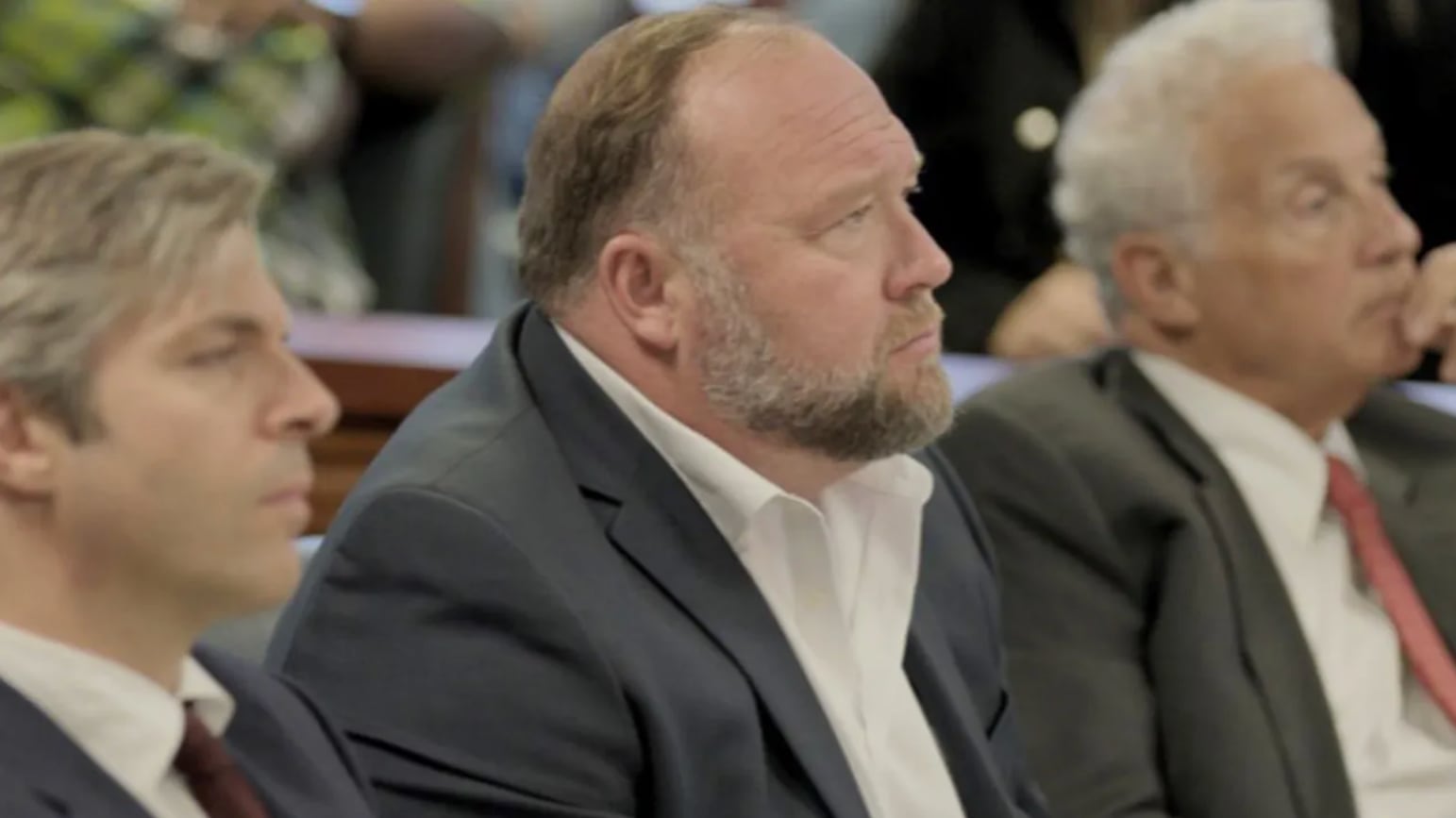The first thing we hear Alex Jones say in The Truth vs. Alex Jones is, “This is a kangaroo court.” Then, he’s shouting on his infamous InfoWars channel: “This is a witch hunt!” Immediately after, we see Jones giggling at a man crying over his dead son, who was brutally shot to death in a first grade bathroom during the 2012 Sandy Hook mass shooting.
What follows is more than two hours of footage indicting Jones of defamation damages stemming from the lies he spread that Sandy Hook was a “hoax” invented to spread gun pushback in America. Dan Reed’s (Leaving Neverland) documentary, which premiered Monday at this year’s SXSW Film Festival, is a scathing portrait of Jones and the vile misinformation he spread about the Sandy Hook tragedy. On the plus side, it’s also gives the parents of the victims some much-deserved retribution against the man who sent their lives into a tizzy of death and rape threats, assault, and other vitriol online following the worst day of their lives.
The doc begins with Jones’ first lies, spread on InfoWars in late 1990s and early 2000s. Former members of the production team recount Jones’ drive to report on radiation spreading throughout California. After he sent a crew to the state to film themselves recording radiation levels, Jones grew irate with them for airing factual data that proved there was no radiation issue at all. He cut the crew off and reported inaccuracies about radiation levels rising instead. A few months later, Jones skyrocketed in fame after deeming 9/11 was carried out by the American government. All of this geopolitical “news,” former workers of Jones allege, was spread in order to gain attention and help sell Jones’ plethora of supplements on air.
Then, the film recounts the horrors of Dec. 14, 2012, in which a gunman shot and killed 20 six- and seven-year-old students, as well as six staffers at Sandy Hook Elementary School in Connecticut. Parents of deceased students Daniel Bardin, Emilie Parker, and Jesse Lewis recall the day, remembering sending their kids to school even in a snowstorm because they were all so excited to celebrate the holidays in the days leading up to winter break. Daniel Jewiss, a lead investigator into the Sandy Hook tragedy, summarizes the events of the six-minute-long massacre, describing in detail the moment in which the gunman took out around a dozen children who were crammed into a bathroom. Later, one of Jones’ accomplices says it would be impossible to kill so many children at once. But it is possible, because they were pushed into the corner “like sardines,” Jewiss says, by their teacher in a last-minute attempt to save their lives.
The parents sob and whimper as they quietly talk about seeing their children, who are riddled with gunshots, cold, and distorted, and with fragments from their teachers’ body parts, who attempted to shield the kids from being shot. There’s around 20 minutes of heart-wrenching recollection of the tragedy, undercut directly after by Jones, who begins to claim that the shooting was “staged” the same day as those 26 souls’ lives were cut short. Robbie Parker, the father of slain six-year-old Emilie Parker, says he just wanted to be left alone by the media and particularly Jones, so he assembled a press conference. “I had just wanted to share something about who my daughter was,” Parker says in an interview. But as soon as the press conference wrapped, Jones and his team labeled Parker a crisis actor. This resulted in dozens and dozens of threats on Emilie’s memorial page on Facebook, calling the child a “whore” and claiming she was still alive.
After continuing to target Sandy Hook parents, Jones hired Wolfgang Halbig as an “ultimate credible authority” to continue to deny that Sandy hook actually happened. Halbig sat for an interview in the documentary, saying he still believes that the tragedy never happened because there were no trauma helicopters sent to retrieve the injured children. There were no trauma helicopters, one of the parents says bluntly, “because the kids were dead.”
Still, Halbig insists that he’s right. In older interviews on InfoWars, Halbig claims that nobody died. Then, in this doc, he asserts that he never said that nobody died. Now he thinks that maybe, just maybe, a few people died. “I just hope and pray that I’m not wrong,” Halbig says. If he is wrong, he adds, “I probably need to go to a mental hospital.” Kelley Watt, another vocal Sandy Hook denier, says in the doc that she is “as convinced” that no one died as Leonard Pozner is convinced that his son, the six-year-old Noah Pozner, died at Sandy Hook.
The doc then gets into the multiple trials held against Jones, which resulted in a $1.5 billion settlement in damages owed to the Sandy Hook families. Jones’ attorney F. Andino Reynal compares these lawsuits to lynch mobs, claiming that’s why he found the case so “appealing” in the first place. Reynal calls Jones “an American hero” for speaking his mind. He’s not the best lawyer—in the end, Reynal accidentally sends all of the data on Jones’ phone to the lawyers prosecuting Jones. Here, the lawyers find that Jones has lied multiple times, and that he could also be tried for perjury.
And yet, Jones persists, insisting that he has always told the truth—or, at least, his version of the truth. The judge in Jones’ first suit, Maya Guerra Gamble, grows more and more irate with the InfoWars host. One line in particular from Gamble earned a flurry of laughs at the doc’s premiere screening: “When you hear ‘sustained’ you have to stop talking.” Another: “You must tell the truth while you testify. This is not your show.” Tensions reach their peak when Jones spreads an image of this judge setting the statue of liberty on fire on InfoWars while the trial is still ongoing. He also says Sandy Hook parent Neil Heslin seems “autistic” while the trial is ongoing, but later apologizes to Heslin in person, saying, “I think I’m autistic too.”
As of March 2024, the millions and millions of dollars Jones owes the Sandy Hook families remains unpaid. He has filed for bankruptcy. But The Truth vs. Alex Jones gives the Sandy Hook parents the final word: They have used this trial to drive home the importance of truth and authenticity, a vital message that the film successfully gets across. We end on a parent unpacking the backpack of her dead son, the homework he was supposed to be sent home with but never completed. “He was cheated in life and cheated afterwards,” says his mother, a powerful message that massive lies have massive repercussions.






